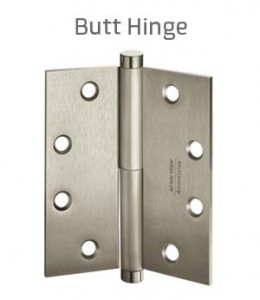You see them every day, but I’d be willing to bet they probably don’t occupy a large part of your brain.
Hey, I work with them and they don’t even occupy a large part of my brain, so don’t feel guilty.
However, it’s good to know a thing or two about door hinges, especially if you’re about to start a new construction project. There are a few options and they offer different levels of security. Throw in whether you need them for interior doors or exterior doors and you have several options available.
Let’s dig right in.
The Types of Door Hinges
You have two main types of door hinges: A butt hinge and a continuous hinge.
Butt Hinge
The butt hinge is one you probably see the most. They’re pretty much on virtually every residential door, and on most commercial doors, for that matter. They have a pin that mates the two leaves of the hinge together and there are several different types of butt hinges.
(Fun Fact: The butt hinge got it’s name because it’s fastened on the edge of the door, which butts against the frame, stop molding, or casing. Disappointingly, it has nothing to do with actual butts at all, and that makes my 12-year-old-boy sense of humor sad.)
Continuous Hinge
You’ve probably seen a continuous hinge or two in your day, but they’re mostly on exterior doors. If they happen to be on an interior door, it’s a very heavy one. These are either pin and barrel type hinges or geared hinges. Geared hinges are linked together by two gears that are inside of a casing. Pin and barrel hinges have a pin that slide into a barrel.
With a continuous hinge, any gap between the door and the frame is covered by the hinge. This prevents thieves and vandals from being able to pry the door open using that gap as leverage with a crowbar or anything else they could use as a lever.
Security Features
On your exterior doors, security features are going to play a big role in what hinges you choose.
Non-Removable Pins
Non-removable pins are a security feature used on butt hinges that are pretty self-explanatory. The pin in the barrel on this hinge is there to stay. The only way the door could be removed from its opening is if someone were to cut it off of its hinges. This would take a lot of time and would be pretty loud.
I would be willing to bet no thief would want to take that risk.
 Security Studs
Security Studs
I’ve also heard these referred to as “security tabs,” but security studs is a much more common term. These also go on butt hinges and they lock the two leaves of the hinge together when the door is closed. The stud on one leaf mates into the hole on the other leaf.
If the pin is removed from its barrel or, if the barrel itself is cut off the hinge, the two leaves remain locked together, forcing whomever is trying to get in (without a key or proper credentials) to pry the frame away from the door.
Again, most criminals aren’t willing to take that risk.
Hardware Grade
We love to talk about hardware grades here on LockBytes and door hinges are no exception. Just like with most things in the industry, you can’t put low grade hardware on high-use doors. You’re just asking for a disaster that way.
This goes for door hinges, too!
Those that are installed on high-traffic doors really need a heavy-duty Grade 1 hinge. These will hold up longer and, because most high-traffic doors tend to be heavier, a heavy-duty Grade 1 hinge will help keep your door in alignment, where it’s supposed to be.
Don’t skimp!
Are you not sure where to start when it comes to door hinges?
Did you know we have an entire department that specializes in door and hardware that can answer any questions you might have?
Contact us today and let us help!

